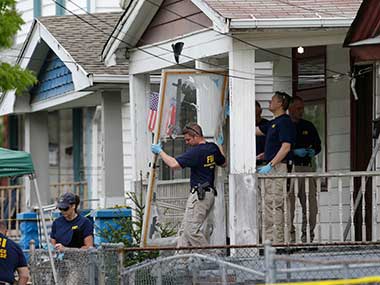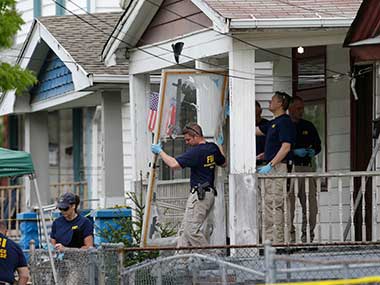Cleveland: Neighbours said on Tuesday they had called police on at least two occasions over the years to check on the peeling, rundown house where three women, who vanished separately about a decade ago, were being held. Police said they visited the house twice regarding two unrelated incidents. While the rescue of the women Monday exhilarated and astonished the Midwestern US city of Cleveland, police are facing questions about their handling of the case. One neighbour said she called police after her daughter saw a naked woman crawling on her hands and knees in the backyard of the house a few years ago. Another said he called after hearing pounding on the doors and noticed plastic bags over the windows. Police showed up at the house both times, the neighbours say, but never went inside. Police Chief Michael McGrath said Amanda Berry, Gina DeJesus and Michelle Knight had apparently been held captive in the house since their teens or early 20s. Authorities arrested three brothers, ages 50 to 54. One of them, former school bus driver Ariel Castro, owned the home, situated in a poor neighbourhood dotted with boarded-up houses. No immediate charges were filed. The break in the case came when the 27-year-old Berry kicked out the bottom of a locked screen door at the home and used a neighbour’s telephone to call police. Choking back tears, she breathlessly told the dispatcher: “Help me. I’m Amanda Berry. I’ve been kidnapped and I’ve been missing for 10 years and I’m, I’m here, I’m free now.” Police arrived to find the two other women, along with a 6-year-old girl who authorities said was believed to Berry’s daughter. Police would not say who the father was or where the child was born. [caption id=“attachment_762047” align=“alignleft” width=“380”]  The house where the women were found. Associated Press[/caption] Authorities would not say how the women were taken captive, whether they were restrained inside the house or if they had been sexually assaulted. Police said they were trying to be delicate in their questioning of the women, given their ordeal. Cleveland police came under heavy criticism in a separate case a few years ago following the discovery of 11 bodies in a man’s home and backyard in another poor section of the city. Neighbours had long complained about foul odors, and the victims’ families charged that police didn’t take the reports of missing women seriously. As for whether police this time overlooked hints about the women’s fate, city Safety Director Martin Flask said Tuesday morning: “At this point, I can confirm that we have no indications that any of the neighbours, bystanders, witnesses or anyone else has ever called regarding any information, regarding activity that occurred at that house.” However, he said authorities were still checking all databases of calls to police, fire and emergency services. Two neighbours said Tuesday that they were alarmed enough by what they saw at the house to call police on two occasions. Elsie Cintron, who lives three houses away, said her daughter once saw a naked woman crawling on her hands and knees in the backyard several years ago and called police. “But they didn’t take it seriously,” she said. Another neighbour, Israel Lugo, said he heard pounding on some of the doors of Castro’s house, which had plastic bags on the windows, in November 2011. Lugo said officers knocked on the front door, but no one answered. “They walked to side of the house and then left,” he said. Neighbours also said they would see Castro sometimes walking a little girl to a neighbourhood playground. And Cintron said she once saw a little girl looking out of the attic window of the house. “Everyone in the neighbourhood did what they had to do,” said Lupe Collins, who is close to relatives of the women. “The police didn’t do their job.” Police did go to the house twice in the past 15 years, but not in connection with the women’s disappearance, officials said. In 2000, before the women vanished, Ariel Castro reported a fight in the street, but no arrests were made, Flask said. In 2004, officers went to the home after child welfare officials alerted them that Ariel Castro, a school bus driver, had apparently left a child unattended on a bus, Flask said. No one answered the door, according to Flask. At some point in the investigation, police talked to Castro and determined there was no criminal intent, he said. Police identified the three suspects as Ariel Castro, 52; Pedro Castro, 54; and Onil Castro, 50. Attempts to reach Ariel Castro in jail were unsuccessful. Ariel Castro was well known in the mainly Puerto Rican neighbourhood. He played bass guitar in salsa and merengue bands. He gave children rides on his motorcycle and joined others at a candlelight vigil to remember two of the missing girls, neighbours said. They also said they would sometimes see him walking a little girl to a neighbourhood playground. Tito DeJesus, an uncle of Gina DeJesus, played in bands with Castro over the last 20 years. He recalled visiting Castro’s house but never noticed anything out of the ordinary, saying it had very little furniture and was filled with musical instruments. “I had no clue, no clue whatsoever that this happened,” he said. A relative of three brothers arrested in Cleveland says their family is “totally shocked.” Juan Alicea says the arrests of his wife’s brothers have left relatives “as blindsided as anyone else” in their community. Alicea says he had eaten dinner with Castro at a different brother’s house shortly before the arrests were made but hadn’t been to the home of his brother-in-law Ariel Castro since the early 1990s. Ariel Castro’s son, Anthony Castro, said in an interview with London’s Daily Mail newspaper that he now speaks with his father just a few times a year and seldom visited his house. He said on his last visit, two weeks ago, his father wouldn’t let him inside. “The house was always locked,” he said. “There were places we could never go. There were locks on the basement. Locks on the attic. Locks on the garage.” Anthony Castro, who lives in Columbus, also wrote an article for a community newspaper in Cleveland about the disappearance of Gina DeJesus just weeks after she went missing, when he was a college journalism student. “That I wrote about this nearly 10 years ago — to find out that it is now so close to my family — it’s unspeakable,” he told The Plain Dealer newspaper. Over the past decade or so, investigators twice dug up backyards looking for Berry and continued to receive tips about her and DeJesus every few months, even in recent years. The disappearance of the two girls was profiled on TV’s “America’s Most Wanted” in 2005. Few leads ever came in about Knight. Knight vanished at age 20 in 2002. Berry disappeared at 16 in 2003, when she called her sister to say she was getting a ride home from her job at a Burger King. About a year later, DeJesus vanished at 14 on her way home from school. The National Center for Missing & Exploited Children’s CEO, John Ryan, said Berry, DeJesus and Knight likely would be honoured by his group. “I think they’re going to be at the top of the list,” he said. Associated Press
Neighbours said Tuesday they had called police on at least two occasions over the years to check on the peeling, rundown house where three women, who vanished separately about a decade ago, were being held.
Advertisement
End of Article
Written by FP Archives
see more


)

)
)
)
)
)
)
)
)



